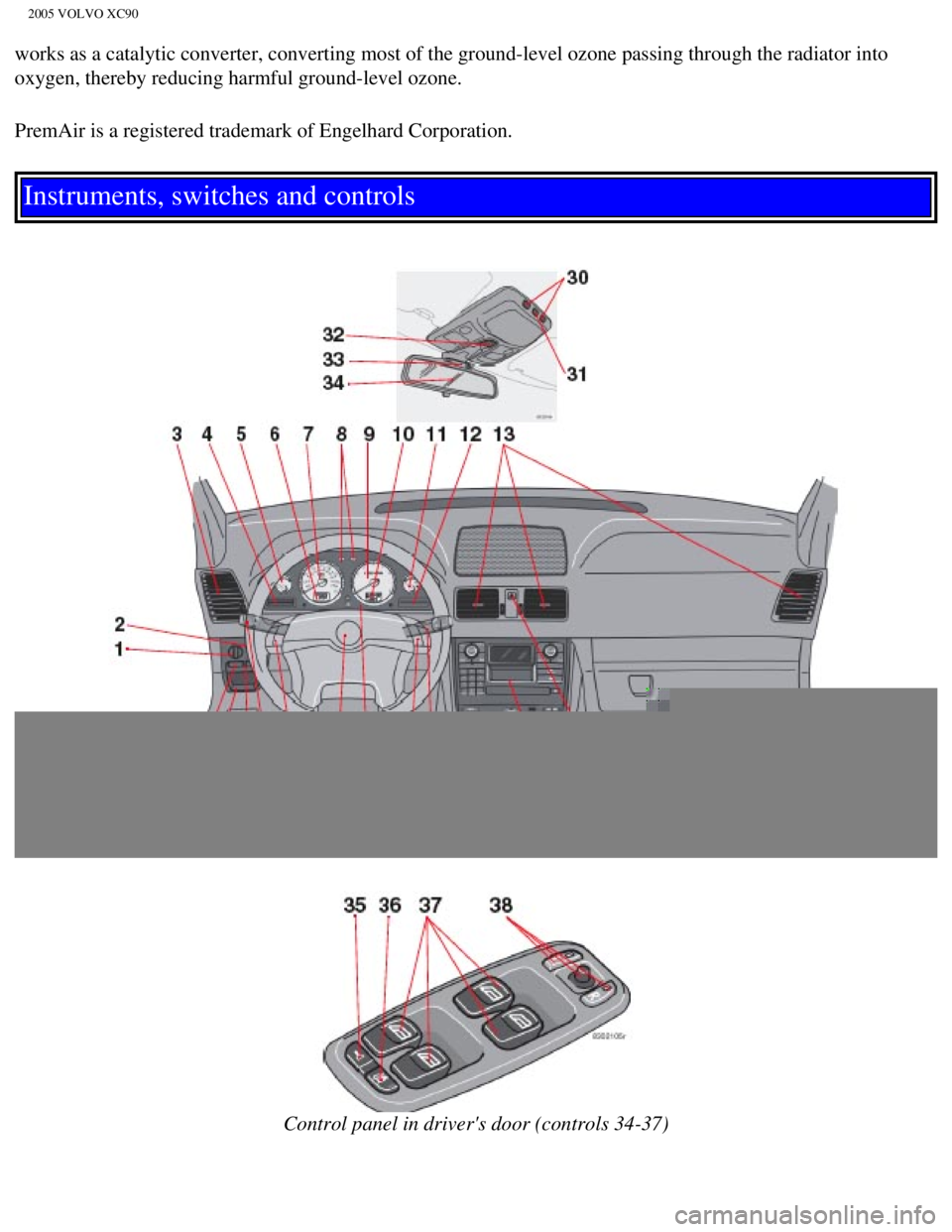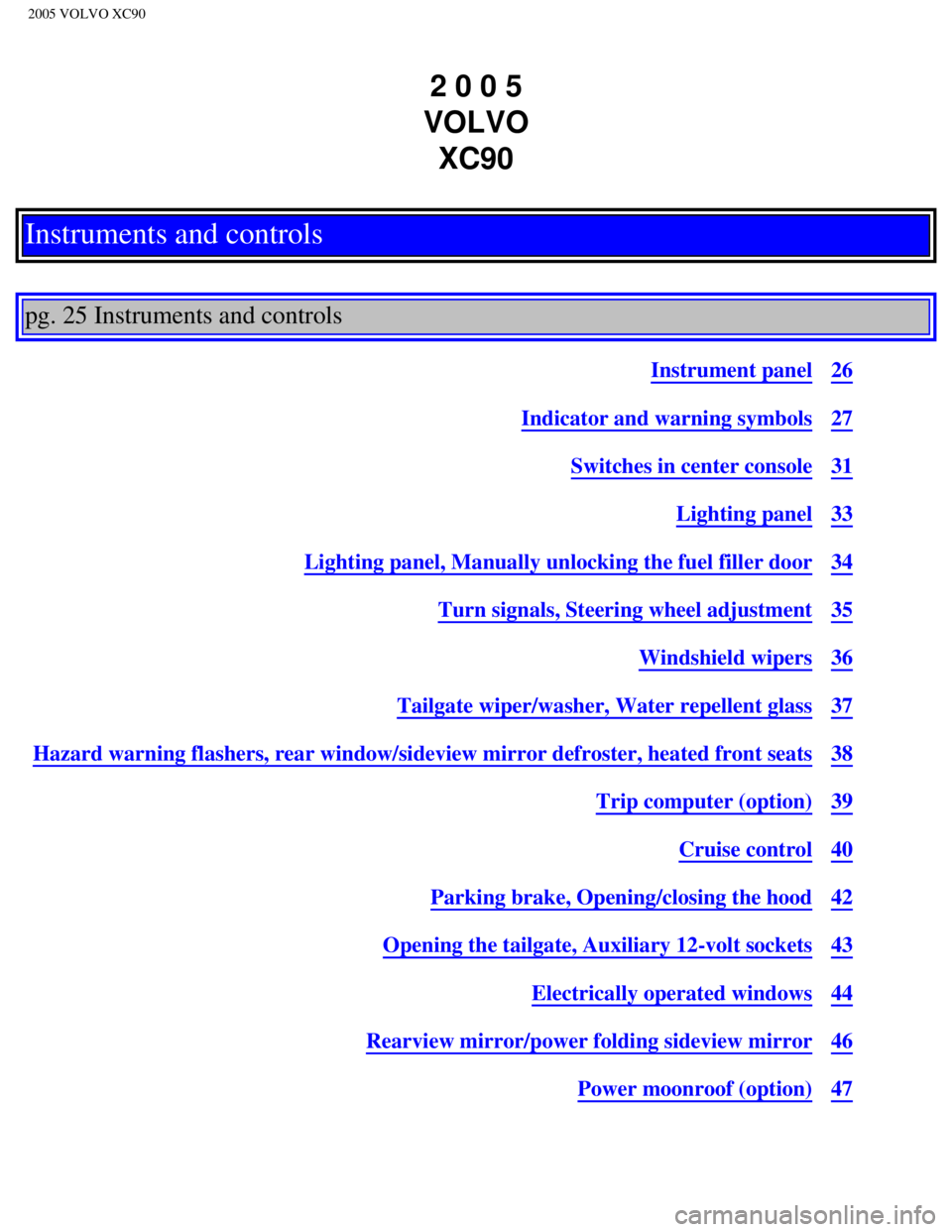2005 VOLVO XC90 instrument panel
[x] Cancel search: instrument panelPage 5 of 263

2005 VOLVO XC90
works as a catalytic converter, converting most of the ground-level ozon\
e passing through the radiator into
oxygen, thereby reducing harmful ground-level ozone.
PremAir is a registered trademark of Engelhard Corporation.
Instruments, switches and controls
Control panel in driver's door (controls 34-37)
file:///K|/ownersdocs/2005/2005_XC90/05xc90_00.htm (5 of 7)12/30/2006 \
4:42:22 PM
Page 6 of 263

2005 VOLVO XC90
1. Headlights/Parking lights 33
2. Instrument lighting 33
3. Panel vents 51
4. Text window 30
5. Temperature gauge 26
6. Odometer/Trip odometer/Cruise control indicator 26, 40
7. Speedometer iv
8. Turn signal indicator lights 26
9. Tachometer 26
10. Ambient temperature gauge, clock, gear indicator 26
11. Fuel gauge 26
12. Indicator and warning symbols 27
13. Panel vents 51
14. Glove compartment 69
15. Hazard warning flashers 38
16. Audio system 175
17. Switches in the center console 31
18. Climate system controls 52
19. Windshield wiper/washer lever 36
20. Audio control buttons in steering wheel 177
21. Instrument panel 26
22. Horn iv
23. Cruise control buttons in steering wheel 40
24. Turn signals, High/low beams 35
25. Front fog lights, Rear fog light 33
26. Parking brake pedal 42
27. Parking brake release handle 42
28. Button for unlocking fuel filler door 33
29. Hood open lever 42
30. Reading lights 65
31. Courtesy light 65
32. Moonroof control (option) 47
33. Seat belt reminder 29
34. Rearview mirror 46
35. Central locking button 79
36. Lockout switch for rear seat power windows 45
37. Power window controls 44
38. Sideview mirror controls 46
file:///K|/ownersdocs/2005/2005_XC90/05xc90_00.htm (6 of 7)12/30/2006 \
4:42:22 PM
Page 15 of 263

2005 VOLVO XC90
WARNING!
Children must never be allowed in the front passenger's seat. Volvo reco\
mmends that ALL occupants
(adults and children) shorter than 4 feet 7 inches (140 cm) be seate\
d in the back seat of any vehicle
with a front passenger-side airbag. See
page 22 for guidelines.
Occupants in the front passenger's seat must never sit on the edge of th\
e seat, sit leaning toward the
instrument panel or otherwise sit out of position. The occupant's back m\
ust be as upright as comfort
allows and be against the seat back with the seat belt properly fastened\
.
Feet must be on the floor, e.g. not on the dash, seat or out of the wind\
ow.
No objects or accessory equipment, e.g. dashboard covers, may be placed \
on, attached to, or installed
near the SRS hatch (the area above the glove compartment) or the area \
affected by airbag deployment
(see illustration on
page 4).
There should be no loose articles, e.g. coffee cups, on the floor, seat \
or dashboard area.
Never try to open the SRS cover on the steering wheel or the passenger s\
ide dash. This should only be
done by an authorized Volvo service technician.
Failure to follow these instructions can result in injury to the vehicle\
occupants.
Safety system warning light in the instrument panel
A self-diagnostic system incorporated in the sensor monitors certain saf\
ety system components. A check
is performed on components such as seat belt locks, SRS, Occupant Weight\
Sensor, SIPS, and/or the
VIC system. If a fault is detected, the warning light will illuminate. T\
he light is included in the warning/
indicator light cluster in the instrument panel. Normally, the safety sy\
stem warning lamp should light up
when the ignition key is turned to positions I, II or III and should go \
out after approximately 7 seconds
or when the engine is started. Check that this light is functioning prop\
erly every time the vehicle is
started.
WARNING!
If the SRS warning light stays on after the engine has started or if it \
comes on while you are driving,
drive the vehicle to the nearest authorized Volvo retailer for inspectio\
n as soon as possible.
file:///K|/ownersdocs/2005/2005_XC90/05xc90_01a.htm (8 of 15)12/30/200\
6 4:42:24 PM
Page 39 of 263

2005 VOLVO XC90
2 0 0 5
VOLVO XC90
Instruments and controls
pg. 25 Instruments and controls
Instrument panel26
Indicator and warning symbols27
Switches in center console31
Lighting panel33
Lighting panel, Manually unlocking the fuel filler door34
Turn signals, Steering wheel adjustment35
Windshield wipers36
Tailgate wiper/washer, Water repellent glass37
Hazard warning flashers, rear window/sideview mirror defroster, heated f\
ront seats38
Trip computer (option)39
Cruise control40
Parking brake, Opening/closing the hood42
Opening the tailgate, Auxiliary 12-volt sockets43
Electrically operated windows44
Rearview mirror/power folding sideview mirror46
Power moonroof (option)47
file:///K|/ownersdocs/2005/2005_XC90/05xc90_02a.htm (1 of 17)12/30/200\
6 4:42:27 PM
Page 40 of 263

2005 VOLVO XC90
pg. 26 Instruments and controls
Instrument panel
1. Turn signal indicators - right - left
2. Text window
The text window displays information and warning messages.
3. Temperature gauge
The pointer should be approximately midway on the gauge when driving. Do not drive the vehicle if
the warning light is on. The text window will provide you with additional information. If the en\
gine
temperature remains high, check coolant level - see
page 139.
4. Trip odometer
The trip odometers are used for measuring shorter distances. The right-h\
and digit gives tenth of a mile/
kilometer. Press the button for more than 2 seconds to reset. Change bet\
ween trip odometers 1 and 2
using one short press on the button.
5. Odometer
6. Speedometer
7. Warning symbol
8. High beam indicator
9. Tachometer
The tachometer shows engine speed in thousands of revolutions per minute\
(rpm). Do not drive
file:///K|/ownersdocs/2005/2005_XC90/05xc90_02a.htm (2 of 17)12/30/200\
6 4:42:27 PM
Page 41 of 263

2005 VOLVO XC90
continuously with the needle in the red area of the dial, which indicate\
s maximum allowable engine rpm
range. Instead, shift to a higher gear or slow the vehicle down. The eng\
ine management system will
automatically prevent excessively high engines speeds. This will be noti\
ceable as a pronounced
unevenness in engine speed.
10. Gear and driving mode indicator
The currently selected driving mode is displayed here. If you use the op\
tional Geartronic function on the
automatic transmission, the currently selected gear will be displayed.
11. Ambient temperature gauge
This display indicates the air temperature outside your vehicle. A "snow\
flake" symbol in the text
window is displayed when the temperature is in the range of 23 - 36° \
F (-5 - +2° C). Please note that this
symbol does not indicate a fault with your vehicle. At low speeds or whe\
n the vehicle is not moving, the
temperature readings may be slightly higher than the actual ambient temp\
erature.
12. Clock/set button
Turn the button to set the clock.
13. Fuel gauge
The fuel tank holds approximately:
Models with 6-cylinder turbo engines - 19 US gallons (72 liters).
Models with 5-cylinder turbo engines - 18 US gallons (68 liters).
When a warning light in the gauge comes on, there are approximately 1.8 \
US gal. (8 liters) of fuel
remaining in the tank.
14. Indicator and warning symbols
pg. 27 Instruments and controls
Indicator and warning symbols
The indicator and warning symbols light up when you turn the ignition ke\
y to the driving position
(position II) before starting. This shows that the symbols are functio\
ning. When the engine starts, all
symbols go out. If the engine is not started within 5 seconds, all symbo\
ls except CHECK ENGINE and
go out. The symbol for the parking brake goes out when the parking brak\
e is released.
Warning symbol
in center of instrument panel
This symbol shines as a red or yellow light depending on the severity of\
the fault that has been detected.
Red symbol -Stop the vehicle as soon as possible in a suitable location and read th\
e message shown in
file:///K|/ownersdocs/2005/2005_XC90/05xc90_02a.htm (3 of 17)12/30/200\
6 4:42:27 PM
Page 45 of 263

2005 VOLVO XC90
Indicator and warning symbols (contd)
Messages in the text window
When a warning light in the instrument panel comes on, a message is also\
displayed in the text window.
After you have read the message, you can erase it by pressing button A (\
see illustration).
NOTE: Certain messages cannot be erased until the condition has been correcte\
d.
If a warning message is displayed when e.g. you are using the trip compu\
ter, this message must be
erased before you can access the function of your choice. Press button A\
to erase the warning message.
You can scroll through the stored messages by pressing button A (see il\
lustration). The text window can
be cleared (the message will be returned to memory) by pressing button\
A again. Message Meaning:
STOP SAFELY: Stop and switch off the engine - to help prevent serious risk of
damage.
STOP ENGINE: Stop and switch off the engine - to help prevent serious risk of
damage.
SERVICE URGENT: Take your vehicle to an authorized Volvo retailer for inspection
as soon as possible.
SEE MANUAL: Refer to your owner's manual. For additional information, please
contact your Volvo retailer.
SERVICE REQUIRED: Take your vehicle to an authorized Volvo retailer for inspection
at your convenience (but preferably before the next scheduled
maintenance).
file:///K|/ownersdocs/2005/2005_XC90/05xc90_02a.htm (7 of 17)12/30/200\
6 4:42:27 PM
Page 49 of 263

2005 VOLVO XC90
12 volt socket
This 12 volt socket can be used to plug in certain accessories such as c\
ellular telephones, etc. The
ignition key must be in position 1 (or higher) for the auxiliary socke\
t to function.
NOTE: The auxiliary sockets can also be used for cigarette lighters, which ar\
e available as accessories
at your Volvo retailer.
pg. 33 Instruments and controls
Lighting panel
A - Headlights and parking lights
All lighting off.
Models with daytime running lights:
Low beam headlights will automatically come on if the ignition key is in\
position II. Front and rear
parking lights, tail lights, side marker lights, and license plate light\
s will also be on. Volvo recommends
the use of daytime running lights. If, however, you would prefer to have\
these lights turned off (USA
only), please consult your Volvo retailer. Please note that the use of \
daytime running lights is mandatory
in Canada.
NOTE: Bi-Xenon headlights (option): Turn the headlight switch to position 0\
to activate a daylight
sensor, which automatically switches the low beams on or off, depending \
on ambient light conditions.
When driving in daylight, the headlights will switch off and the daytime\
running lights will come on. In
darkness, the daytime running lights will switch off and the Bi-Xenon he\
adlights will switch on.
Parking lights on. The parking lights should be switched off when you leave the vehicle to \
help avoid battery drain.
Headlights, parking lights, license plate lights and instrument panel il\
lumination are on if the
ignition key is in position II.
The headlight switch must be in this position before the high beams will\
function (this also applies on
file:///K|/ownersdocs/2005/2005_XC90/05xc90_02a.htm (11 of 17)12/30/20\
06 4:42:27 PM